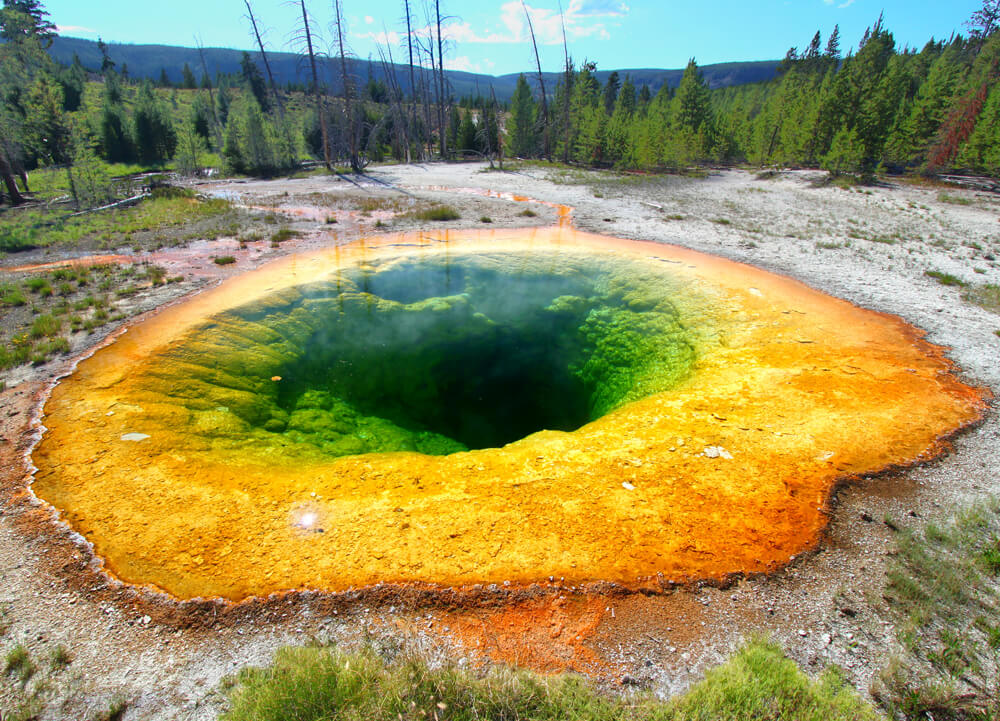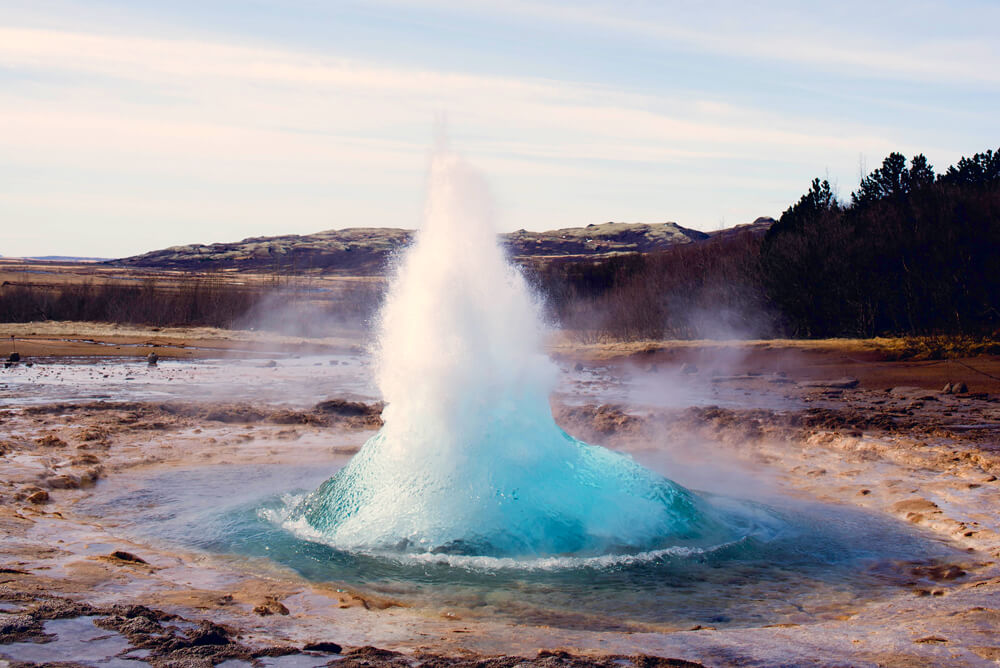

The park is at the headwaters of the Yellowstone River, from which it takes its historical name. Near the end of the 18th century, French trappers named the river Roche Jaune, which is probably a translation of the Hidatsa name Mi tsi a-da-zi ("Rock Yellow River"). Later, American trappers rendered the French name in English as "Yellow Stone". Although it is commonly believed that the river was named for the yellow rocks seen in the Grand Canyon of the Yellowstone, the Native American name source is unclear.
The human history of the park begins at least 11,000 years ago when Native Americans began to hunt and fish in the region. Arrowheads made of Yellowstone obsidian have been found as far away as the Mississippi Valley, indicating that a regular obsidian trade existed between local tribes and tribes farther east. By the time white explorers first entered the region during the Lewis and Clark Expedition in 1805, they encountered the Nez Perce, Crow, and Shoshone tribes.

The most famous geyser in the park, and perhaps the world, is Old Faithful Geyser, located in Upper Geyser Basin. Castle Geyser, Lion Geyser and Beehive Geyser are in the same basin. The park contains the largest active geyser in the world—Steamboat Geyser in the Norris Geyser Basin. A study that was completed in 2011 found that at least 1283 geysers have erupted in Yellowstone. Of these, an average of 465 are active in a given year. Yellowstone contains at least 10,000 geothermal features altogether. Half the geothermal features and two-thirds of the world's geysers are concentrated in Yellowstone.
In May 2001, the U.S. Geological Survey, Yellowstone National Park, and the University of Utah created the Yellowstone Volcano Observatory (YVO), a partnership for long-term monitoring of the geological processes of the Yellowstone Plateau volcanic field, for disseminating information concerning the potential hazards of this geologically active region.
In 2003, changes at the Norris Geyser Basin resulted in the temporary closure of some trails in the basin. New fumaroles were observed, and several geysers showed enhanced activity and increasing water temperatures. Several geysers became so hot that they were transformed into purely steaming features; the water had become superheated and they could no longer erupt normally.
The Yellowstone Caldera is the largest volcanic system in North America. It has been termed a "supervolcano" because the caldera was formed by exceptionally large explosive eruptions. The magma chamber that lies under Yellowstone is estimated to be a single connected chamber, about 37 miles (60 km) long, 18 miles (29 km) wide, and 3 to 7 miles (5 to 12 km) deep. The current caldera was created by a cataclysmic eruption that occurred 640,000 years ago, which released more than 240 cubic miles (1,000 km³) of ash, rock and pyroclastic materials. This eruption was more than 1,000 times larger than the 1980 eruption of Mount St. Helens. It produced a caldera nearly five eighths of a mile (1 km) deep and 45 by 28 miles (72 by 45 km) in area and deposited the Lava Creek Tuff, a welded tuff geologic formation. The most violent known eruption, which occurred 2.1 million years ago, ejected 588 cubic miles (2,450 km³) of volcanic material and created the rock formation known as the Huckleberry Ritdge Tuff and created the Island Park Caldera.
Each eruption is part of an eruptive cycle that climaxes with the partial collapse of the roof of the volcano's partially emptied magma chamber. This creates a collapsed depression, called a caldera, and releases vast amounts of volcanic material, usually through fissures that ring the caldera. The time between the last three cataclysmic eruptions in the Yellowstone area has ranged from 600,000 to 800,000 years, but the small number of such climactic eruptions cannot be used to make an accurate prediction for future volcanic events.


Over 1,700 species of trees and other vascular plants are native to the park. Another 170 species are considered to be exotic species and are non-native. Of the eight conifer tree species documented, Lodgepole Pine forests cover 80% of the total forested areas. Other conifers, such as Subalpine Fir, Engelmann Spruce, Rocky Mountain Douglas-fir and Whitebark Pine, are found in scattered groves throughout the park. As of 2007, the whitebark pine is threatened by a fungus known as white pine blister rust; however, this is mostly confined to forests well to the north and west. In Yellowstone, about seven percent of the whitebark pine species have been impacted with the fungus, compared to nearly complete infestations in northwestern Montana. Quaking Aspen and willows are the most common species of deciduous trees.
There are dozens of species of flowering plants that have been identified, most of which bloom between the months of May and September. The Yellowstone Sand Verbena is a rare flowering plant found only in Yellowstone. It is closely related to species usually found in much warmer climates, making the sand verbena an enigma. The estimated 8,000 examples of this rare flowering plant all make their home in the sandy soils on the shores of Yellowstone Lake, well above the waterline.
In Yellowstone's hot waters, bacteria form mats of bizarre shapes consisting of trillions of individuals. These bacteria are some of the most primitive life forms on earth. Flies and other arthropods live on the mats, even in the middle of the bitterly cold winters. Initially, scientists thought that microbes there gained sustenance only from sulfur. In 2005 researchers from the University of Colorado at Boulder discovered that the sustenance for at least some of the diverse hyperthermophilic species is molecular hydrogen.
Non-native plants sometimes threaten native species by using up nutrient resources. Though exotic species are most commonly found in areas with the greatest human visitation, such as near roads and at major tourist areas, they have also spread into the backcountry. Generally, most exotic species are controlled by pulling the plants out of the soil or by spraying, both of which are time consuming and expensive.

Yellowstone is widely considered to be the finest megafauna wildlife habitat in the lower 48 states. There are almost 60 species of mammals in the park, including the gray wolf, coyote, the threatened Canadian lynx, and grizzly bears. Other large mammals include the bison (often referred to as buffalo), black bear, elk, moose, mule deer, white-tailed deer, mountain goat, pronghorn, bighorn sheep, and cougar.
The Yellowstone Park bison herd is the largest public herd of American bison in the United States. The relatively large bison populations are a concern for ranchers, who fear that the species can transmit bovine diseases to their domesticated cousins. In fact, about half of Yellowstone's bison have been exposed to brucellosis, a bacterial disease that came to North America with European cattle that may cause cattle to miscarry. The disease has little effect on park bison, and no reported case of transmission from wild bison to domestic livestock has been filed. However, the Animal and Plant Health Inspection Service (APHIS) has stated that bison are the "likely source" of the spread of the disease in cattle in Wyoming and North Dakota. Elk also carry the disease and are believed to have transmitted the infection to horses and cattle. Bison once numbered between 30 and 60 million individuals throughout North America, and Yellowstone remains one of their last strongholds. Their populations had increased from less than 50 in the park in 1902 to 4,000 by 2003. The Yellowstone Park bison herd reached a peak in 2005 with 4,900 animals. Despite a summer estimated population of 4,700 in 2007, the number dropped to 3,000 in 2008 after a harsh winter and controversial brucellosis management sending hundreds to slaughter.
To combat the perceived threat of brucellosis transmission to cattle, national park personnel regularly harass bison herds back into the park when they venture outside of the area's borders. During the winter of 1996–97, the bison herd was so large that 1,079 bison that had exited the park were shot or sent to slaughter. Animal rights activists argue that this is a cruel practice and that the possibility for disease transmission is not as great as some ranchers maintain. Ecologists point out that the bison are merely traveling to seasonal grazing areas that lie within the Greater Yellowstone Ecosystem that have been converted to cattle grazing, some of which are within National Forests and are leased to private ranchers. APHIS has stated that with vaccinations and other means, brucellosis can be eliminated from the bison and elk herds throughout Yellowstone.
Starting in 1914, in an effort to protect elk populations, the U.S. Congress appropriated funds to be used for the purposes of "destroying wolves, prairie dogs, and other animals injurious to agriculture and animal husbandry" on public lands. Park Service hunters carried out these orders, and by 1926 they had killed 136 wolves, and wolves were virtually eliminated from Yellowstone. Further exterminations continued until the National Park Service ended the practice in 1935. With the passing of the Endangered Species Act in 1973, the wolf was one of the first mammal species listed. After the wolves were extirpated from Yellowstone, the coyote then became the park's top canine predator. However, the coyote is not able to bring down large animals, and the result of this lack of a top predator on these populations was a marked increase in lame and sick megafauna.